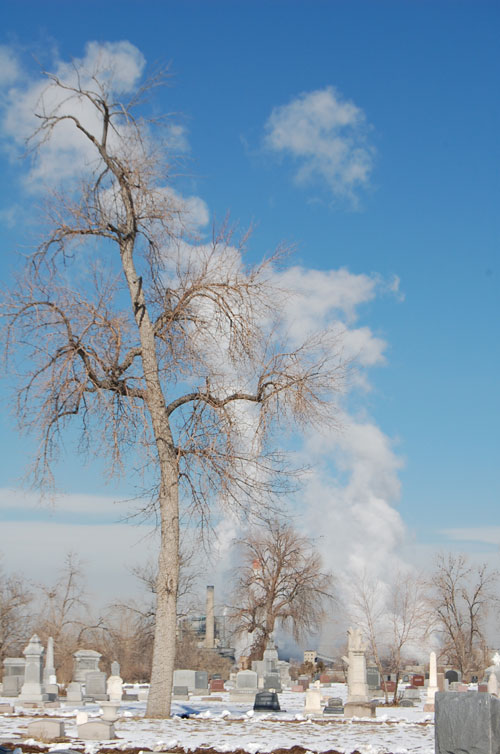
On Digital Storytelling
On Wednesday I had the chance to attend a talk by Joe Lambert at the Colorado History Museum. Joe is the Executive Director and founder of the Center for Digital Storytelling, where he works with my friend Daniel Weinshenker, who runs the Center’s Denver office. The CDS is a non-profit organization based in Berkeley that assists “people of all ages in using the tools of digital media to craft, record, share, and value the stories of individuals and communities, in ways that improve all our lives.”
The topic of Joe’s talk was some evolving ways to create stories of places, or ‘storymapping’, but in reality the talk was a wide ranging discussion of the value of personal stories in building more meaningful life experiences. As a starting place, Joe placed the contemporary story movement in context, as related to other ways of searching for authenticity in our lives. As an example, he mentioned the slow food movement. Joe mentioned that in contemporary society we don’t believe in the third-person, expository voice. It is too easy to lose the real in the commercial, and it’s hard to argue that society doesn’t do its best to promote the “commodification of cool.”
For instance, in their 2007 book, “Authenticity“, Gilmore and Pine argue that “the management of the customer perception of authenticity becomes the primary new source of competitive advantage – the new business imperative.” The subtitle of their book, “What Consumers Really Want”, and their argument for the management of ‘perception’, puts some perspective on their goals with this endeavor. Corporations may not be able to provide real authenticity, but they can provide the appearance of authenticity.
This is not to say that corporations shouldn’t address this issue; of course they should. Our consumer culture isn’t going away any time soon, and whatever companies can do to provide a richer experience associated with their products and services is vital and important. But what Joe is advocating is something more grassroots based or, as he calls it, “community-based creativity.” Joe’s goal is nothing less than using stories to help create a society of producers rather than consumers.
The CDS advocates and teaches a particular form of digital storytelling that encourages sharing (“listening leads to refinement”) and the development of very personal expressions of history and experience. In the CDS technique, a digital story most often ends up being a three to four minute presentation centered around a specific moment where the storytelling gained insight and meaning about their life, their family, their community. Although the tools are based on the latest computer tools, the approach is intentionally non-professional – Joe described the results as “halfway between powerpoint and film.” The core of the CDS training is not so much the technological components but in how to write and edit a story so that is pared down to its essence. The results are often remarkably powerful and emotional.
Of course, this approach is just one on a broad spectrum, from the audio stories recorded and presented by storycorps to the documentaries of Ken Burns and others. Blogs and online journals also provide a great opportunity for the expression of individual experience; one of my favorite story sites, called A mis 95 años (in Spanish), is told from the perspective of a (now 96 year-old) Gallega who reflects on spanish history and contemporary culture.
 Storymapping is an extension of these approaches that makes use of emerging digital mapping technologies to find connections between story and place. For instance, the I-10 Witness Project combines google maps with embedded quicktime videos to offer stories of the history and reconstruction of New Orleans after Hurricane Katrina.
Storymapping is an extension of these approaches that makes use of emerging digital mapping technologies to find connections between story and place. For instance, the I-10 Witness Project combines google maps with embedded quicktime videos to offer stories of the history and reconstruction of New Orleans after Hurricane Katrina.
Murmur is another example of combining story and place; started in Toronto, the team has placed “ears” around the city. When you see an ear (on a light post, for example), you can call a specific number and get a story about that very place on your cellphone. You hear a story of a place, but not just the official story. You experience the ghost of the place. I remember when this used to be…
All this is just the start; already we are seeing the opportunity to present stories in multiple delivery platforms, independent of how the information was recorded. It’s an exciting time to be a storyteller. And really, don’t we all have stories to tell?
The Use of Stories
In his talk, Joe outlined some of the uses for stories; I’ve expanded on a few of them here:
Personal expression
Of course, moving from consumer culture to producer culture requires that ‘this is the age when everone creates’. But there is a richness in the process of expression, and an increasing awareness of the value of each life, including my own and those around me.
Social change
The experience of listening and sharing leads, in my mind, to the broadening of understanding. Through this process we begin to understand at a concrete level the opportunity and importance of working toward social justice.
Teaching
For students, the creation of a personal expression can lead to greater opportunities in the future, based on the combination of personal understanding and passion with real technical and communications skills.
Portfolio
For organizations, personal stories can offer a resource for explaining the value of your activities. It’s marketing beyond marketing, communicating at the individual level.
Community history
For cities interested in engaging the community in creating a sense of place, creating an environment conducive to cultural creatives, it is hard to imagine a better opportunity than the creation of stories. And this can be an opportunity to blend the ‘expert’ with the ‘amateur’; the official story is enhanced and extended by the voice of the individual.
Beyond these uses, I also find that stories have extensive value in the design process, to encourage innovation in product and service design. I use storytelling as a idea generation and refinement technique in conjunction with other qualitative (ethnographic) research, including interviews, journaling, and observation. The CDS is also working in the way, specifically working with nurses and patients to gain a better understanding of the health care experience.
International Day for Sharing Stories
Storytelling isn’t just something to be used. The truth is it’s how we connect, how we understand ourselves, our world, our experience. It’s fun, and it adds richness to our lives. We all tell stories, and the more we listen to the stories of others, the richer our experience and understanding.
In conjunction with the Museum of the Person (Museu da Pessoa) and Stories for Change, the Center for Digital Storytelling has announced that May 16 is international day for sharing life stories. Why May 16th? Well, it’s Studs Turkle’s birthday. Seems like a good enough reason to me.

